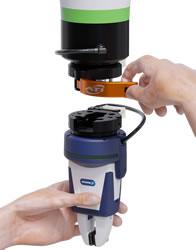CoaXPress Express over Fiber Optic Cables Opens Up New Opportunities in High-Speed Imaging
An extension of the existing CoaXPress 2.1 specification, CXPoF supports data transport from a camera to the host PC over fiber optic cabling instead of coaxial copper cable. CXPoF combines CoaXPress 2.1 bandwidth with fiber optic's virtually unlimited cable lengths, immunity to electrical noise, and lighter and smaller footprint.
WOBURN, MA, MARCH 2, 2023 -- Introduced last year, CoaXPress over Fiber (CXPoF) is an emerging machine vision technology that opens up an exciting new realm of high-speed imaging opportunities. An extension of the existing CoaXPress 2.1 specification, CXPoF supports data transport from a camera to the host PC over fiber optic cabling instead of coaxial copper cable. CXPoF combines CoaXPress 2.1 bandwidth with fiber optic's virtually unlimited cable lengths, immunity to electrical noise, and lighter and smaller footprint.
FIRST ADOPTERS
Early adopters of CXPoF have been end-users requiring exceptionally long cabling such as Intelligent Traffic Systems and military ballistics testing, or where electrical isolation is required due to high-EMI interference as is the case with sensitive medical equipment.
Other industries are expected to follow. That's because along with its technical benefits, CXPoF offers economic advantages owing to its use of Ethernet networking components. Compared to the machine vision market, Ethernet-based networking has far greater sales volumes which, in turn, have driven its component prices down. Lower-priced Ethernet components, such as cables and connectors, can drastically reduce the cost of a CXPoF vision system. For example, a 30M quad CXP-12 coaxial cable costs over $600, while a 30M QSFP+ AOC (Active optical cable) costs about $125.
Fewer fiber optic cables are required to transmit similar amounts of data, therefore reducing the complexity of the cable run, lowering system costs, and minimizing potential failure points, especially if extenders were previously required for long-distance applications.
200 GBPS SPEEDS
Fiber optics transmit data as pulses of light through strands of fiber made of glass or plastic. When bundled with hundreds of other strands, the resulting fiber optic cable will transmit more data at faster speeds and over much longer distances than high-grade copper cables. Instead of requiring four CXP-12 links, CXPoF transmits 40 Gbps on a single QSFP+ (Quad Small Form Factor Pluggable) transceiver module and a single fiber optic cable.
As speeds increase further from 12.5 Gbps per link to the JIIA's expected 25 Gbps, CXPoF appears to be the path of least resistance. In the near future, we will likely see CXPoF move towards 4 x 25 Gbps = 100 Gbps using QSFP28 modules or 4 x 50 Gbps = 200 Gbps with QSFP56 modules. As data, automation, and machine vision enable new levels of efficiency, these higher transfer speeds will be a great asset to manufacturers pursuing the Industrial Internet of Things.
INSTALLATION INSIGHTS
CXPoF will change the way system integrators do their jobs. For one, fiber optic cables do not represent a fire hazard since heat is not dissipated, therefore eliminating that safety concern. Second, the cables can withstand significant pull forces without suffering breakage over long runs compared to copper cabling. Third, fiber optic cables are not damaged by inclement weather, moisture, or temperature extremes to the same extent as coaxial or Ethernet cables, giving integrators a safer option outdoors. Finally, being lighter and smaller in diameter than other cable types, fiber optic cables can more easily be threaded on machines, robots, aircraft, and ground vehicles.
UPGRADE PATH TO CXPoF
As an extension of the CoaXPress protocol, CXPoF provides the generic GeniCam programming interface for hardware and software and is independent of any operating system. Upgrading an existing system will require CXPoF-compliant cameras and frame grabbers, along with fiber optic cabling, transceivers, and connectors. Vendors are just beginning to recognize the market potential of CXPoF. Consequently, hardware choices are limited today but are projected to grow exponentially as has been the case with previous CXP upgrades.
One of the first vendors to embrace CXPoF is BitFlow. Its new Claxon Fiber frame grabber has a fiber transceiver slot supporting QFSP+ compatible fiber cable assemblies. The board provides four connections to support one quad-link CXPoF camera, two dual-link CXPoF cameras, or four single-link CXPoF cameras while featuring the same half-Size x8 PCI Express Gen 3.0 platform as the company's previous CXP frame grabbers. Connected cameras are Plug-and-Play with automatic link speed and camera parameter detection. Cameras can be accurately synchronized or can operate completely independently. Whether in a traditional machine vision system, for military use, or in a research laboratory, the Claxon Fiber makes it simple to swap out an older frame grabber in a host PC to gain the positive performance and economic benefits of CXPoF.
Learn more at www.bitflow.com
Featured Product

